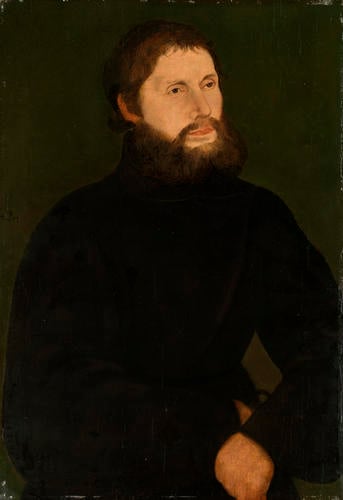-
1 of 253523 objects
Martin Luther as "Junker Jörg" 1521?
Oil on panel | 54.2 x 37.0 x 1.3 cm (support, canvas/panel/stretcher external) | RCIN 402656

Previously attributed to Lucas Cranach the Elder (1472-1553)
Martin Luther as "Junker Jörg" 1521?
-
This painting depicts Martin Luther (1483-1546) whilst he was disguised as the aristocratic Junker Jörg. This curious event occurred at a time when Luther’s life was endangered; his religious Theses was so radical that Emperor Charles V had placed him under an imperial ban and he was under the constant threat of arrest or murder. In order to protect him Elector Frederick the Wise had him abducted and held captive at Wartburg, where Luther remained for the following year disguised as an aristocrat called Junker Jörg. During this time Luther’s publications and ideas became increasingly popular, but the public believed their religious champion to be dead. Lucas Cranach the Elder (1472-1553), a friend of Luther, produced an image of the disguised Reformer in order to prove he was still alive. Cranach depicted this subject in a woodcut and at least two paintings (one in the Museum de Bildenden Künste; Leipzig and another now in Weimar). The mixed potency of a painting by one of the most popular artists of the day depicting the revolutionary Reformer during a remarkable period of his life means that several versions by the circle of Lucas Cranach the Elder were also created. The current work is now believed to be one of these imitations. There is little doubt that this work depicts Luther in his disguise. The black robe with a high collar and trimmed beard fit with the fashion for aristocrats of the day, and match the original paintings and woodcut. Further to this, there are similarities in the facial features. For example the shape of the eyes and inner line of the lip follow the genuine Lucas Cranach paintings. However the face of the royal collection image is smoother than those it mimics; the brow is not furrowed and the nose is not so bulbous. The portrait is also presented in a different composition. The long format differs from the Leipzig depiction and the positioning of the hands differs from both the painting at Leipzig and Weimar. Prince Albert (1819-1861) had a great appreciation of early German art and was significantly interested in acquiring these works for the Royal Collection. He was also a committed Lutheran and maintained an interest in the Reformer throughout his life. He purchased this portrait at an unknown time whilst it was still attributed to Lucas Cranach the Elder, introducing to English tastes an artist who was, at that time, not at all well-known in Britain.
Provenance
Purchased by Prince Albert; recorded in the Little Corridor at Windsor Castle in 1861
-
Creator(s)
-
Medium and techniques
Oil on panel
Measurements
54.2 x 37.0 x 1.3 cm (support, canvas/panel/stretcher external)
71.8 x 57.6 x 5.0 cm (frame, external)
Category
Object type(s)
Alternative title(s)
Dr Martin Luther (1483-1546)